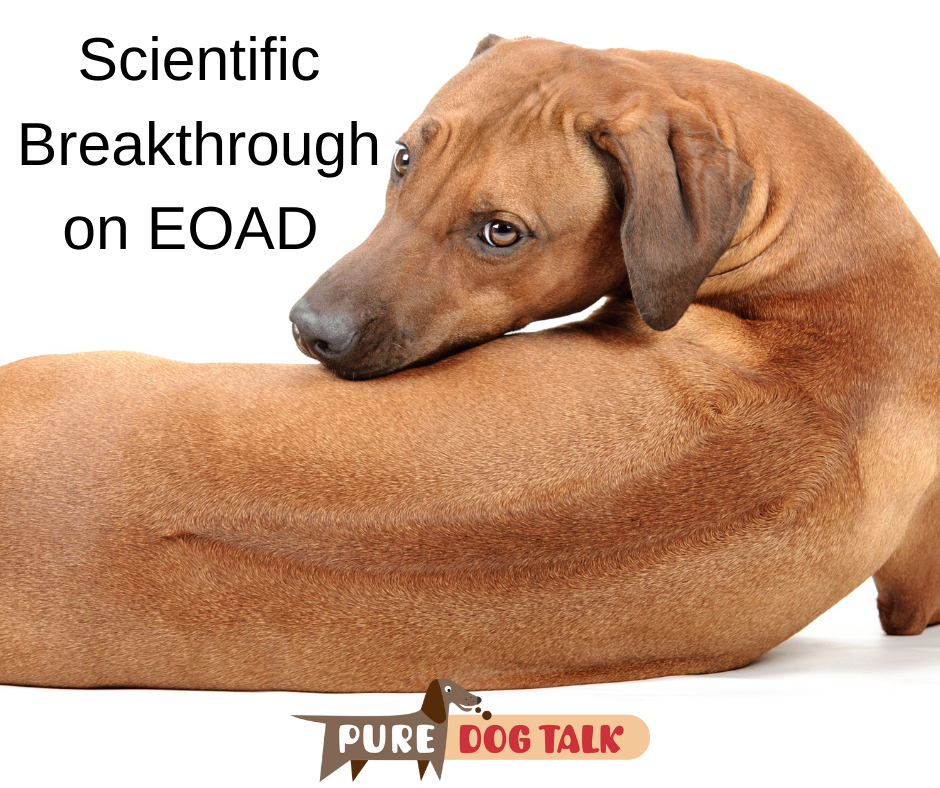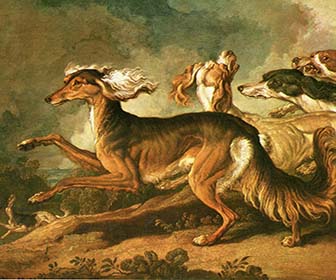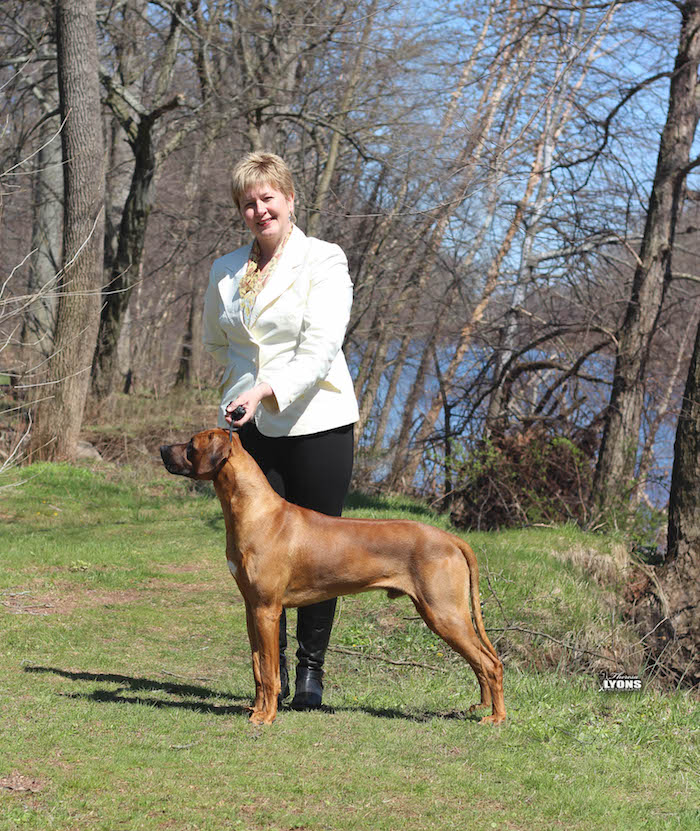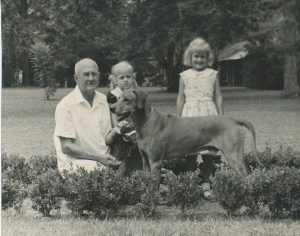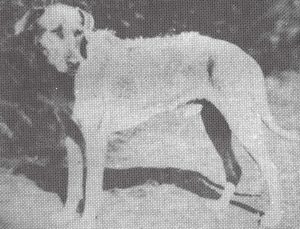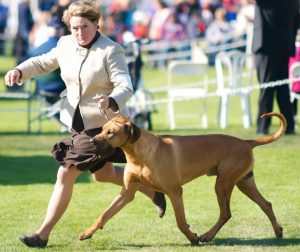522 – EOAD Gene Identified in Rhodesian Ridgebacks
EOAD Gene Identified in Rhodesian Ridgebacks
Adam Boyko, co-founder of Embark, and Rhodesian Ridgeback breeder Denise Flaim join host Laura Reeves to discuss EOAD (Early Onset Adult Deafness) in Ridgebacks and Embark’s discovery of the genetic cause that can identify affected and carrier dogs before the condition develops.
“EOAD is early onset adult deafness,” Flaim said. “It’s a form of deafness that’s not related to color. Many breeds, like dalmatians, the way the white overlays the cochlea impacts deafness. This is just a simple autosomal recessive, inherited the same way brown nose color is. If you have two copies of this recessive gene, if you are a Ridgeback, you become deaf.
“The interesting thing in Ridgebacks is these puppies are born hearing. So if you are a breeder who wants to do your due diligence and BAER test your puppies at 8 weeks, they’ll all hear. What then begins to happen is they start to go progressively deaf. The males quickly, usually by six months are completely deaf and the bitches can take from 12 to 18 plus months.
“(This test) identifies if your dog is a carrier or not. If your dog is a carrier, you simply don’t breed it to another carrier and you’re free and clear. This is a really important point because the tendency among dog breeders, especially those who want to be really, really virtuous and really, really ethical, is to say, ‘oh, I’m going to identify all these carriers and get them out of my breeding program.’ Which is, of course, what you don’t wanna do.
“You certainly don’t want to increase the frequency of this gene in the population, but what you want to do is manage it. The thing is it’s never what you know, it’s always what you don’t know. It’s never what you worry about, it’s always what you don’t worry about. So yes, we’ve got this marker for deafness, but that deafness carrier you’re throwing out of your breeding program may not carry for a really devastating disease for which we don’t have a test. So, like anything, moderation and taking the bigger view is really important.”
Teamwork for the win…
“Project Dog started working with breeders like Denise,” Boyko said, “and recruited a whole bunch of samples and was able to find an associated region. But sequencing of a deaf dog didn’t yield any candidate variants that were causing the mutation. So, you’re sort of stuck in this world, do we want to offer a linkage-based test, which we know probably isn’t going to be 100% accurate, or do we wait until we can find a mutation test. For a while, there was just a linkage test was all that could be offered.
“So, Embark came onto the scene. We, of course, have a large database of dogs, of Ridgebacks and others, and so we were able to recruit more cases, more controls. We were able to verify the association Project Dog found. It’s like ‘yeah, this is definitely on chromosome 18, right here. There had been advances in the genomics. We put some scientists on it …. and sure enough a mutation did find itself. It was in gene EPS 8L2, which was a fantastic gene because it’s also associated with early onset deafness in humans, in recessive forms.”
Hear the REST of the story on today’s episode. Just click play on the bar above.
Adam Boyko
Adam is an associate professor in Biomedical Sciences at the Cornell University College of Veterinary Medicine, focused on the genomic investigation of dogs. Adam’s research has addressed fundamental questions of dog evolution and history, disease and trait mapping, and advancing genomic tools for canine research. Adam has coauthored over 40 peer-reviewed scientific papers, including research in Nature, Science, and the Proceedings of the National Academy of Science and is a member of the Board of Trustees for the Morris Animal Foundation. He is a graduate of the University of Illinois, Urbana-Champaign and received an MS in Computer Science and a PhD in Biology from Purdue University before his postdoctoral work at Cornell and Stanford.
Denise Flaim
Denise is a professional journalist, author and former Newsday staff writer and columnist who is lucky enough to write about the thing that she loves — dogs!
In 2015, Denise founded Revodana Publishing, which focuses on dog books written by experts and fanciers with a deep and time-forged understanding of their subject matter.
Denise is a member in good standing of the Rhodesian Ridgeback Club of the United States (www.RRCUS.org) and the Western Hound Association of Southern California, and is a board member of the Morris & Essex Kennel Club (www.morrisandessexkennelclub.org).
The long-time Ridgeback breed columnist for the AKC Gazette, she is the past chair and historian of the RRCUS Health & Genetics Committee, and now serves as a member of the Rhodesian Ridgeback World Congress Health Committee (www.worldridgebackhealth.org).
503 – Examining the History of Sighthounds with Bo Bengtson
Examining the History of Sighthounds with Bo Bengtson
Bo Bengtson, author, publisher and Whippet breeder, attended his first dog show in 1958 in his native Sweden. He joins host Laura Reeves for a deep dive into the intricacies of sighthounds.
“It was, right away, like lightning struck,” Bengtson said. “I was 14 years old and I just knew right away that this was what I wanted to devote my life to. It was really fascinating. It was, as someone once said, a combination of zoo and circus and theater …
A passion for sighthounds
“You have to know a little bit about coursing if you’re involved in sighthounds. They have remained the same for thousands of years, the basic type. They weren’t breeds early on but different types of sighthounds. if you look at the early description of coursing which is the pursuit of game with sighthounds … that is a sport that’s now these days illegal in most of US… It’s been superseded by lure coursing, which is an artificial form of coursing.

“Hunters Homeward Bound,” 10th Century AD. Courtesy of Bo Bengston.
“(Sighthounds developed) before firearms basically, when the only way you had to hunt was through the dogs and whatever they could course and kill was basically today’s dinner. Firearms made sighthounds very much superfluous. And I think the sport then became very much a status symbol. (Sighthounds) are of course aesthetically pleasing and so many rich people and aristocratic people preferred to hunt with sighthounds, not because of need but because it was a beautiful spectacle and pretty expensive spectacle too. In various parts of the world, Queen Elizabeth I was very fond of coursing. In Russia they coursed with Borzoi. And in the Far East there were Salukis.
What IS a Sighthound?
“There is no official definition of what a sighthound is. So there is a great disagreement about what breeds actually count as sighthounds. You can count as few as four or five as pure sighthounds and as many as 40 as “sighthound related” or different types of breeds we don’t know in this country. Some we wouldn’t define as breeds but more as types.
(Listen to fascinating conversations about the Caravan Hounds of India here and here.)
History of sighthound development
“I think we have to go back again a couple of thousand years because there have probably always been different sizes of greyhounds. Greyhound types. The big ones which were the ancestor of the modern greyhound. And we have the different, smaller ones that were ancestors of whippet and the Italian greyhounds. I think that Whippets, although they weren’t described as a breed until late 1800s, they have certainly been around much longer. Catherine the Great of Russia had little English greyhounds she called them. And they were very important to her. She nursed them herself and they slept on a pink couch in her bedroom. But whether they’re Italian greyhounds, whether they were whippet, who knows. I mean they were very small and whether Italian greyhounds or whippets, it is kind of irrelevant these days.
“The Greyhound and the Saluki are sort of the “ur” sighthound, what sighthounds are supposed to be like. … if you take one step away from Saluki you get the Afghan Hound, which is a little more powerful. If you take several steps away from the Greyhound, you get the Ibizan Hound and you get the Portuguese Podengo and that kind of thing.”
Listen to the full episode for more detailed insights into all things sighthound.
223 — Rhodesian Ridgeback: Power and Elegance
Balancing act of the Rhodesian Ridgeback
Denise Flaim, Rhodesian Ridgeback breeder, judge and historian, shares her knowledge as the RRCUS 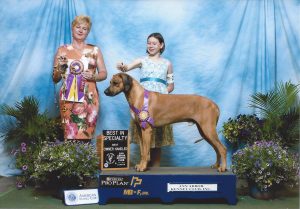 National Specialty kicks off in Colorado.
National Specialty kicks off in Colorado.
The first impression of a Rhodesian Ridgeback, Flaim said, is a “smooth dog with an unbroken fluid line from the top of the head, lovely crested neck, smooth withers, straight topline, gently sloped croup, slightly longer than tall, handy sized for trotting all day. Well angled. Not an empty front, moves freely and effortlessly. Lovely head, round dark eye, triangular ear.”
The Ridgeback, Flaim noted, is that perfect balance of speed and strength. The original dogs routinely coursed large African antelope. As with other sighthounds, the size and bone of the breed always parallels the prey it hunts. They need to be heavy enough to bring down large game like a 200-pound Nyala; lithe and fast enough to catch it. While the breed features a diversity of style within type, the ideal is a dog lacking exaggeration in any part.
“If you don’t know (a breed’s) history you’re doomed,” Flaim said “because you can’t understand its function and morphology.”
Ch. Swahili Jeff Davis — first American champion — with owner and founding Ridgeback breeder Col. Morrie de Pass of Mississippi.
Ridgebacks in Africa
In brief, according to Flaim, when the Dutch went to southern Africa in the late 1600s, they found an unimproved “border collie looking” dog that had a dorsal rise of hair on its back, Flaim summarized. These indigenous dogs that hung out with Koi Koi people, interbred with the Continental dogs, resulting in dogs that had native knowledge, resistance to tse tse flies and more.
The Boers moved to Rhodesia in the late 1800s, and a popular big game hunter acquired ridged bitches and interbred them with his pack. The resulting dogs were excellent at lion hunting.
Flaim was quick to clarify what that actually entailed. The dogs would be taken with rich European hunting parties, in small packs of two or three, to find a lion and harass it, like a matador. Overall athleticism that let the dogs get out of the way of claws was most important.
“Any Ridgeback foolhardy enough to make contact with a lion, soon exited the gene pool in an unceremonious fashion,” Flaim said.
What travels with the ridge?
The breed’s trademark ridge is important, Flaim observed, because “nothing exists in nature if it’s not functional. In Ridgebacks, the dogs that carried the ridge were superlative hunters and could survive in the harsh climate of southern Africa.
“Who knows what native knowledge or traits travel with that ridge,” Flaim said. “For example, Ridgebacks don’t jump into standing pools of water. They want graded entrances. In Africa, if you jump into a standing pool of water you encounter something that wants a snack.”
Rhodesian Ridgeback parent club website: https://www.rrcus.org/
And Allison Foley, Leading Edge Dog Show Academy, tells us how to use cornstarch for dematting.

